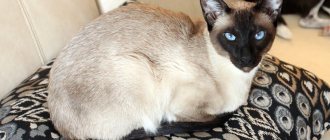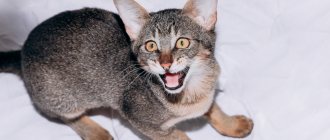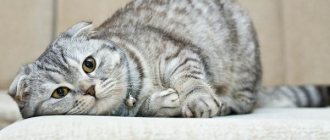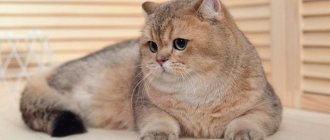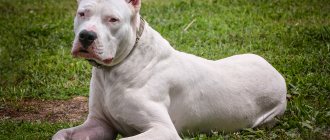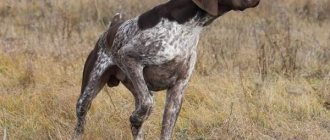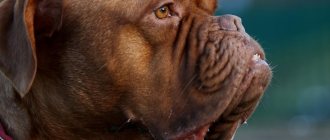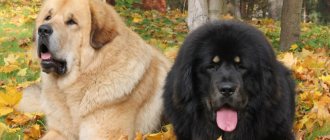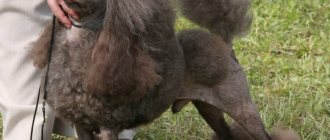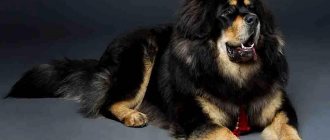Pixiebob is a cat that looks like a mini lynx. Powerful paws, a stocky body, barely noticeable tufts on the ears, coupled with a short tail - these are the characteristic features of this cat breed. An attentive and cold glance, slightly from under the brows, only emphasizes the close relationship between the pixie-bob and such a wild representative of the cat as the North American lynx.
Bred back in the 80s of the last century, pixie beans are still very popular, especially in Canada and the USA.
Description and features
The desire to have an elf with a short tail at home is quite feasible, because this is how “pixie-bob” is translated from English. Therefore, all you need to do is turn your attention to the breed of cats with that name. Such pets make ideal companions: self-sufficient, discreet, affable, friendly and loyal.
The pixie bob boasts an original appearance, having clear similarities with the North American lynx. Actually, this is what the breed was intended to be by breeders, who painstakingly bred it with exactly these characteristics. And therefore, cats of this breed are distinguished by:
- massive body;
- strong large paws;
- short, low-set tail;
- coat marked with medium-sized and small spots;
- sideburns that complete the look of a lynx;
- in some cases, tassels on the ears.
The pixie bob's head is pear-shaped with a wide muzzle and a powerful chin. It has rounded ears at the ends, slightly tilted forward. The deep-set eyes of such cats have heavy eyelids. The color of the iris at birth is blue. But after six months it changes its color to green, brown or golden.
The nose of the representatives of the breed is brick in color, slightly humped, and wide; paw pads are dark; the tip of the tail is black or chocolate; The dark whiskers at the base may be white at the tips. According to the standards, a larger number of toes than usual is acceptable.
Pixiebobs are incomparable in size to wild lynxes; they are much smaller. As for cats, that is, the female half, even in adulthood they rarely reach a weight of more than 5 kg. But cats in this respect differ from their other brothers.
The pixie bob breed was created by crossing a forest cat with a domestic cat.
If males of other breeds, reaching the age of one year, practically stop their growth, male domestic lynxes develop and increase in size up to 4 years, and their body at the end of adulthood may well reach a ten-kilogram mass.
Buy a pixie bob kitten
It is impossible to buy a healthy purebred kitten of this rare and at the same time popular breed on sites like Avito, since even official professional nurseries with specialist breeders have appeared in Russia quite recently. The number of nurseries is small, which also affects the cost of pixie bob kittens .
Breeders provide new owners with documents for the cat they are purchasing and share valuable information on the care and pedigree of the animal.
Breeding mini-lynx kittens is a serious and responsible matter, so the prices are undemocratic:
- a pet-class kitten will cost 50 000-70 000
rubles;
- Breed-class cat costs 100 000-230 000
rubles;
- valuable show class cat is sold at a price 200 000-300 000
rubles
You can consider such prices to mean that getting a short-tailed cat with the face of a forest cat is not so easy.
Nurseries engaged in breeding pixie bobs:
- Pixie House
- Novosibirsk - RUSSPIXI
— Moscow
Nicknames for pixie bob
global $ads_google;
//data-ad-slot=”2475549904″ $ads_google = empty($ads_google) ? false : true; ?> if ($ads_google == false) {?> $ads_google = true; ?> } ?> For some reason, it is difficult for many to choose a suitable nickname for a small kitten. To solve the problem and find a beautiful name for your pet, you need to follow some simple tips:
- Hissing sounds are desirable in a cat's name. If there are none, it’s not so scary, but when the nickname “whistles” or “hisses,” the cat reacts to it much more readily;
- the pet’s appearance, shade, build, features are taken into account;
- pay attention to the manifestations of the cat’s character traits.
A convenient table with ready-made options makes choosing a nickname much easier.
| Girl | Boy | ||
| Barbie Siya Gaitana Lina Vikki Naomi Floris Zara Greya Tsetka Indira Veta Lynx Shumka Tasya | Malya Doll Pusya Vesya Puffy Chica Nuta Fiesta Olive Penelope Sina Shusha Tuma Adelia Nira | Radik Billy Floppy Wiz Mason Saffron Grif Vitas Volt Hasan Salvador Cardinal Mars Orel Basik | Iago Azur Vincent Elizar Alicer Cortes Sax Morphy Chingiz Aygun Asker Frank Zlatan Lapwing Buttercup |
Kinds
looks attractive in the photo The breed itself is divided into two varieties, because its representatives come with short and long hair. However, according to standards, hair dimensions, even in special cases, should not exceed 5 cm.
Shorthaired cats have thick, straight hair. The fur on the belly is slightly longer than on other parts of the body. Its structure is fluffy and soft. In long-haired representatives of the breed, the hair lies along the body. But these are not all the differences between house elves.
The color of the pussies of this breed is characterized by brown, reddish, red, mouse tones with light tips of the hairs. Accordingly, pixie bobs come in a variety of colors. These shades are subject to seasonal changes.
Cats of this breed are distinguished by their tabby color. Its signs include: the scarab sign, that is, a dark, clear mark on the forehead in the form of the letter “M”; dark stripes on the chest, resembling necklaces in outline; rings in the form of bracelets on the tail and legs; on the lighter-colored abdomen there are rows of “medallions.”
is distinguished from the cat community by its short tail, which is most often not characteristic of its other relatives. But the representatives of the breed themselves differ from each other in their length. Their tail can measure only 5 cm, but no less. However, there is more. Sometimes, when the animal's hind leg is extended, it can reach the hock joint.
Common Defects
The external disadvantages of pixiebobs, which prevent them from receiving the title of winner at shows and reduce points, include:
- fuzzy eyebrows and chin;
- flat back;
- tail less than 5 cm or elongated;
- irregular head shape;
- excessively elongated and smooth coat;
- the belly is not light enough, the skin sac on it is not pronounced;
- small ears;
- Round eyes;
- wool collar;
- non-standard color.
History of the breed
The chronicle of elf-lynxes began at the end of the 20th century in America, since it was there and then that this breed was bred. Its ancestor was a cat whose name was Pixie. And she was born from a very interesting couple: a cat with a short tail and polydactyly (more than usual number of fingers), bought in Washington, and a very large, short-tailed wild cat, rescued and selected by breeder Carol Brewer.
Pixie herself, who was soon born from such parents, had a muzzle that looked like a wild lynx and had spotted fur the color of sea sand. This cat turned out to be so interesting that Brewer soon began to implement a successful program to develop a new original breed.
Strictly speaking, experiments on crossing forest cats with domestic cats had been carried out before this point, but only in the 80s of the last century they had their worthy results. This is how the pixie bob breed , officially recognized internationally in 1995.
Pixiebob is a large breed of cat with a short tail.
Character
It is interesting that in terms of behavior and habits, representatives of this breed are more reminiscent of dogs rather than pussies. They are not at all opposed to their owner leading them on a leash during walks, while in a cat’s nature there should seem to be a desire to roam the streets without restrictions.
The fear of water is also not inherent in them, unlike those pussies who are afraid to even get their fur wet. Piskibobs do not exhibit feline selfishness and arrogant detachment; they are devoted to humans like a dog. However, they are also jealous, since they really do not like to share the attention of their patron with anyone else.
But such a desire does not reach the point of militant aggression, for the highlight of their character lies in calmness and restraint. Pussy lynxes, although descendants of wild cats, are not warlike, and therefore get along well with other animals, including the pets of the owner’s house, as well as with his children. The pixie bob cat , despite its inner equanimity, loves to jump, run and frolic.
Although he observes moderation in everything: he plays, but does not play pranks. Showing sociability, she always remembers dignity while keeping her distance. This creature will not tolerate humiliation and injustice towards its own person. Such pussies do not allow themselves to meow loudly, as ordinary cats do, but like dogs they can growl.
These creatures do not like change, and therefore it is better not to transport them from place to place unless necessary. In general, they are domestic in everything, but the free forest nature of the pixie-bob can manifest itself if it is left without attention and care for a long time, because without active contact with people it can become wild. However, reasonable intelligence is also a property of the nature of short-tailed pussies.
Such pets are characterized by good intuition, obedience, and mutual understanding with their patrons. And what’s especially nice is that they easily learn order and follow it. From everything that has been written, it is clear that the character of the pixie bob, with proper upbringing, completely allows the owners to turn the descendant of wild cats into an ideal pet, moreover, gentle and affectionate.
What to feed
In everyday life, representatives of the breed are quite unpretentious. They will happily eat dry food, canned food, and prepared salad from fresh vegetables.
In addition, they can catch a small bird or rodent, if there are any within the territory, and snack on fresh meat.They need plenty of water, so the owner must make sure that the pet has a bowl of water available to them.
Nutrition
In caring for the health of little “elves”, it is not recommended to overfeed them, but rather regularly monitor the amount of food eaten. Also, when preparing for a trip before the road, you need to remember that it is better to transport such animals on an empty stomach.
Adult cats and kittens need only two meals a day on a schedule - morning and evening. The main element of the diet can be dry food, specially selected in accordance with the breed. Although the descendants of forest cats do not require any special diet, they are essentially omnivores.
But in accordance with their wild nature, they love to eat raw meat. Lynx cats often indulge themselves with such a delicacy, since they are good at catching mice. And they usually do not disdain the flesh of birds. Pixie-bob kittens also benefit from lean, raw meat.
Only it should be given crushed and added to porridge. Fish, cottage cheese, eggs, bread, and fresh herbs are also important to them. Small kittens should eat at least six times a day, but as they grow, the number of feedings decreases to three.
Pixie-bob has an affectionate, flexible character
Reproduction and lifespan
Breeding cats of this breed is far from easy. And there are several reasons for this. Firstly, the characteristics of lynx kitties play a role here: their conservatism, aversion to changing places, as well as semi-wild roots, despite their almost canine nature. This sometimes seriously prevents owners of purebred specimens from participating in exhibitions with them.
Here, beloved pets, seemingly docile and affectionate at home, can show wariness and aggression, which will not be easy to cope with. As for matings, difficulties arise in this issue again. Pixiebob genes are special. Therefore, they cannot be arbitrarily crossed with any desired breeds, but only with each other. And this makes it very difficult to choose a partner.
And most importantly, this breed of cat was bred in North America and is now mainly bred only in the USA and Canada; moreover, it is considered the national treasure of these countries, and therefore the export of such kittens to other continents is difficult. Because of this, a purebred is still considered a rarity in Russia
And the number of specimens we have does not yet allow us to create a worthy domestic population. All this makes the breed insufficiently known in our country, and therefore arouses little interest among breeders and prospective owners. Although nurseries for breeding elf-lynxes are still appearing, including in Moscow.
An interesting feature of kittens of this breed is their late maturation and formation. Therefore, for an amateur, given the rather large size of domestic lynxes, it is sometimes not difficult to mistake an immature individual for an adult. And the full life cycle of a pixie bob from birth to death is usually no more than 13 years.
Owner reviews
Oksana: “Fred has been living with me for a year now. The kindest and smartest creature, as soon as you stroke it, the “rattling” begins. He’s always waiting for me from work, it’s obvious that he’s bored. Very loyal."
Oleg: “An active breed, you won’t get bored with them. I take my cat to the dacha and to visit. Sociable, does not scratch, even if children squeeze. Smart and obedient, doesn’t do any mischief.”
Olga: “We have grown into a beauty. Tassels have appeared on the ears - now a real little lynx. She is very playful and active, loves to swim, we and the children adore her.”
Care and maintenance
The first thing that free lynx elves need is long walks, that is, sufficient movement and fresh air. This is the first thing owners of pixiebobs should think about. After all, for the healthy development of pets, you can’t just take them outside for five to ten minutes and calm down.
The call of wild ancestors, despite the innate intelligence, still makes itself felt. Therefore, from the very first days of a special cat’s stay in the house, the owner needs to devote a lot of time to its upbringing, accustoming it to the rules of the house and its requirements. But the health of pixiebobs and their immunity, as a rule, do not cause concern.
Such animals are not afraid of the cold and feel great at any time of the year. A pet's claws can become a big problem for the owner, as they can ruin carpets and furniture in the house. Therefore, for a pixie-bob, cutting them is very desirable. True, you can protect yourself from these worries by accustoming your pet to a scratching post in early childhood.
The next necessary element of care is weekly combing of the coat. This helps not only to maintain a pleasant appearance, but also prevents unwanted large amounts of hair from entering the animal’s esophagus.
Brushing your teeth, ears, and monthly bathing are also important. The latter usually does not cause big problems. Lynx cats not only love water, but they themselves often want to swim when they see any body of water.
Breeding
The period of pregnancy and childbirth, as a rule, passes by pixiebobs without any difficulties. There are usually 2–3 kittens in a litter. The best age for mating is 2–2.5 years. A pixie bob cat can have up to 3 litters in 2 years.
Typically, cats of this breed give birth to 2–3 kittens.
Mating should be carried out 3–10 days after the start of estrus, which can be determined by the following signs:
- change in appetite (decrease or, less commonly, increase);
- anxiety;
- increased licking of the genitals;
- swelling of the genital loop.
The usual reaction to heat in cats of other breeds, which is expressed by loud meowing, is not common among pixiebobs.
Pregnancy lasts 2 months. It does not imply any special changes in caring for your pet, except for increasing the amount of proteins, fats and vitamins in the diet. Childbirth also usually takes place without complications, but if the owner does not have experience in participating in the delivery of cats, then it is better to contact a professional.
Price
Purchasing a purebred kitten of this breed, of course, is best done in a professional, trustworthy nursery. There you can get not only the relevant documents: pedigree, veterinary passport, but also valuable advice on keeping a short-tailed “forest elf” and its proper home education. If the kitten has a wet nose, clean eyes and ears, a cheerful appearance, and is well-fed, then most likely it is healthy.
The price of a pixie bob is usually less than $15,000. If it is lower, then most likely it is not a purebred representative of the breed. And the actual cost directly depends on the kitten’s compliance with standards, its pedigree and gender. Purchasing a breed-class pet will cost much more than the stated price.
How to choose a kitten
Buying a pet is a responsible step. You are getting not just an animal, but a future friend for many years. Choose your kitten responsibly. There is no need to blindly follow the recommendations of the breeder or friends. Listen to your intuition: it will not deceive you.
Do not buy a Pixie Bob that is less than three months old. Until this age, he needs maternal care and cannot yet boast of a stronger psyche. Babies separated from cats early often grow up fearful. You will spend a lot of effort to get close to such a pet.
Take a closer look at a kitten that is moderately playful and shows healthy curiosity. He should easily make contact, sniffing your hand and not being afraid to come closer. Carefully examine the baby you like. Healthy kittens have shiny and soft fur, and their eyes, nose and ears are clean. Don't forget to feel your tummy. It should be soft, relaxed.
The breeder always has documentation that confirms the prestige of the pedigree. If this is important to you, please read it in advance. If they refuse to provide you with papers, you should think twice. Probably, such pixiebobs are not purebred, and in the future they can puzzle you with a lot of health problems: physical and psychological.
It is also not recommended to buy a kitten that looks sick, moves sluggishly, and is afraid of loud sounds and bright lights.
Interesting Facts
- The number of toes on the paws of the most ordinary cat is limited to eighteen: there are five on the front legs, and four on the hind legs. But pixiebobs are unusual pussies, also because they are the only breed in the world in which multi-fingeredness (polydactyly) is not at all considered a deformity or deviation, but the most common norm. It's completely acceptable. And this is documented in the breed standards. Charming purebred “wood elves” can have from five to seven fingers on each of their paws.
- The descendants of wild cats can only surprise their owners with their health. But a predisposition to some of the diseases was still revealed. In particular, among them are hypertrophic cardiomyopathy, that is, heart problems, as well as ailments in the reproductive system. The risk of being exposed to such a scourge in pixiebobs is so serious that it is recommended that they undergo an ultrasound every year. This is a preventive measure that helps to identify unwanted signs in cats in a timely manner.
- It has already been mentioned that our short-tailed elves do not like change. However, it is curious that their conservatism goes so far that they show dissatisfaction even with minor changes. For example, they may not really like the new hair color of their beloved housewife or the wallpaper in the room that has been re-pasted.
- The pride of lynx kitties are the cute tassels on their ears. But they do not grow in all representatives of the breed, but only in some. Therefore, owners of cats with such a typical lynx decoration can be considered very lucky.
- Pixiebob is not only the name of the original cat breed. This is also a fashionable short haircut for women. Moreover, its name has nothing to do with pussies. And the hairstyle was invented and brought into life by Irene Castle, a foxtrot performer. The dancer decided that it was much more convenient for her to perform her dances with short hair, so she cut her hair in a special way. Now there is a pixie-bob with bangs , and not only with regular, neat ones, but also with asymmetrical, graduated ones. Sometimes the haircut has a slightly different design, standing out in the face area with elongated strands.
general characteristics
There are semi-longhaired and shorthaired pixiebobs.
Character
Their representatives are able to quickly adapt to a new family, becoming affectionate and flexible. They jump, run, play great, love children and quickly find a common language with other pets who live with them. Even though pixiebobs look a little wild, they are actually kind and gentle. They are not afraid of water, open space, or low temperatures. When a pixie bob meets its owner, it makes interesting sounds, something between a chirp and a purr.
A cat of this breed becomes the favorite of the male owner. Most likely, this is due to the fact that its behavior is similar to that of a dog. These cats, like many purebred dogs, are easy to train, and even without much effort, you can teach a cat the simplest commands.
Intellectuals, they are naturally endowed with good memory and intelligence. Thanks to these qualities, they quickly learn the purpose of the tray and scratching post, and once they learn it, they will not deviate from the rules for using them. If you want, you can teach your pix to go to the toilet, and with more diligence, to flush after yourself. The prospect, as you can see, is not bad, considering the benefits of this enterprise - reducing the cost of toilet fillers and saving time on cleaning and disinfecting the tray.
Appearance
Cats of this breed are quite massive and large, with males being much larger than females. Their body has an elongated shape with well-developed muscles and heavy bones. They are characterized by a deep and powerful chest, a slight arch on the back slightly below the shoulders.
Their legs are massive, the forelimbs are slightly shorter than the hind limbs. The paws are large and round in shape. Cats have a short and low-set straight tail, sometimes with a bend. Its length can range from 2.5 to 15 cm. The head is large, elongated, with a rounded forehead and clearly visible brow ridges. A wide and large nose, and in some representatives of the breed it can even be snub-nosed.
The ears are wide at the base, with rounded ends, slightly moved back. Usually you can see dark tufts on the ears, which makes cats look very much like a lynx. The neck of pixiebobs is short and thick. The eyes are almond-shaped and medium in size. Their color can be green, golden yellow or yellow-green. Their fur has a special property - luminescent.
In shorthaired cats, the hair does not lie close to the body and is not dense. The fine undercoat is soft to the touch. Semi-longhaired representatives of the breed have a weakly defined undercoat with medium-density wool. There is no long feather around the neck, and on the cheeks the fur is long and forms a kind of whiskers. The coat color of pixiebobs can be agouti, tabby, or striped.
